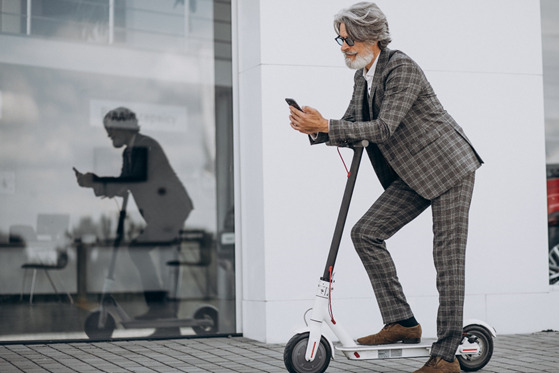

The rapid urbanisation of cities across the globe brings a myriad of problems, from congested roads to air pollution, rising greenhouse gas emissions and public health concerns. The traditional modes of transportation dominated by private vehicles proved unsustainable for the growing population and the demand for efficient, clean, and inclusive mobility solutions. Cities are responding to these issues by exploring innovative transport modes, and one of the most promising solutions emerging on the horizon is micromobility.
Micromobility, by definition, refers to small, lightweight vehicles designed for short-distance travel, including e-scooters, e-bikes, traditional bicycles and electric skateboards, that typically operate at speeds less than 25 km/h (15 mph). Micromobility is revolutionising how people commute in urban areas and is poised to play a central role in the future of urban mobility. This article explores the potential of micromobility as a sustainable, efficient and equitable transportation solution for modern cities.
1.What is Micromobility?
Micromobility encompasses various vehicle types, human-powered and electric. Some of the characteristics defining these vehicles are as follows:
Micromobility, characterised by small, lightweight vehicles for short-distance travel, offers a promising solution for last-mile connectivity challenges in urban areas. Electric scooters (e-scooters) have gained popularity as a convenient and eco-friendly mode of transportation in recent years, particularly for short trips within city centres.
2.Factors Driving the Adoption of Micromobility
There are hopeful prospects for integrating micromobility services, such as e-scooters and shared bikes, into urban transport systems. Micromobility improves last-mile connectivity, reduces traffic congestion and contributes to environmental sustainability. A successful micromobility integration requires effective coordination between public transport and micromobility service providers and infrastructure adjustments like dedicated lanes and parking to ensure maximum convenience and user safety. Several factors contribute to the rapid adoption of micromobility in cities.
3.Benefits of Micromobility
a) Micromobility contributes significantly to reducing urban carbon footprints. Vehicles like e-scooters and e-bikes produce minimal or no emissions, making them an environmentally friendly alternative to traditional cars. A study by the International Transport Forum found that cities can reduce CO₂ emissions by seven per cent by using micromobility for ten per cent of trips of less than five kilometres. Micromobility also reduces urban air pollution, particulate matter (PM2.5) and nitrogen oxides (NOₓ) in the atmosphere. Cities like Paris and Madrid achieved better air quality after implementing extensive micromobility networks.
b) Micromobility promotes physical activity, especially when commuters choose bicycles over motorised options. A higher level of physical activity helps combat lifestyle-related diseases such as obesity, cardiovascular diseases and diabetes. Even electric-assisted vehicles like e-bikes encourage moderate physical activity despite the lower intensity of physical exertion. Studies found that active commuters experienced less stress and better overall mental well-being than car commuters. Exposure to outdoor environments and the autonomy provided by micromobility can enhance psychological health.
c) Some of the substantial economic advantages of micromobility are:
d) Micromobility improves urban liveability by reducing traffic congestion. The streets designed for shared use by pedestrians and micromobility users are safer and more inviting. The population of cities like Copenhagen and Amsterdam, which prioritise cycling infrastructure, enjoy a higher quality of life, from reduced noise pollution to better access to green spaces.
4. Challenges to Micromobility Adoption
A crucial part of integrating micromobility is creating safe and convenient routes for micromobility users, which requires mapping out dedicated bike lanes and sidewalks and adhering to traffic regulations. A well-defined infrastructure ensures user safety and promotes the widespread adoption of micromobility services. It is also crucial to spread awareness among potential users to encourage them to adopt micromobility. While the benefits of micromobility vehicles are apparent, they also present challenges that require addressing to ensure widespread adoption.
a) Many cities lack adequate micromobility infrastructure. Without dedicated bike lanes and parking zones, users often have to compete for space with pedestrians and other vehicles, which increases the risk of accidents.
b) Safety concern remains a critical barrier to the adoption of micromobility. One of the concerns is collisions between micromobility users and motor vehicles, particularly in areas without proper infrastructure. There are also concerns about vehicle malfunctions and accidents due to improper use by inexperienced riders.
c) The different micromobility regulations across cities often create uncertainty for operators and users. Some key regulatory issues concern where micromobility vehicles are allowed (roads vs. sidewalks) and providing dedicated parking spots to prevent clutter.
d) Residents of some cities view micromobility as a nuisance, citing issues like improper parking, overcrowded sidewalks and perceived danger. Public education and thoughtful urban design can aid in overcoming these perceptions.
5. Solutions and Strategies for Success
User-friendly digital platforms and mobile applications ensure a seamless experience. They allow users to locate nearby micromobility services, unlock vehicles and make payments effortlessly. The intuitive design enhances user convenience and encourages the public to embrace micromobility options. It is crucial to incorporate sustainability practices and safety guidelines into the micromobility integration plan by emphasising eco-friendly transportation options, promoting helmet usage and ensuring compliance with traffic regulations to create a sustainable and safe urban mobility ecosystem. Cities must also implement supportive policies and infrastructure to realise the full potential of micromobility.
a) Infrastructure Investment:
b) Cities must develop clearregulatory frameworks that promote safe and responsible micromobility use. The regulations must include speed limits, restrictions on where micromobility riders can legally ride and fines for improper parking.
c) Establishpublic-private partnerships between the governments and micromobility providers. Providing subsidies and incentives for the public sector can lower user costs while encouraging private companies to develop technological innovation and operational expertise.
d) Conduct public awareness and educational campaigns to build public trust and encourage responsible use. Cities like Seattle and Barcelona have successfully implemented initiatives that teach riders about safety and proper usage.
6. Successful Case Studies
a) In France,Paris embraces micromobility as a part of its ambitious plan to reduce car use. The city’s extensive bike-sharing program, Vélib’, and a growing fleet of e-scooters transform the daily commute. It makes micromobility safe and accessible by investing in cycling infrastructure, including over 1,000km of bike lanes.
b) A city in Colombia,Bogotá, implemented Ciclovía, a weekly event that provides exclusive access to cyclists and pedestrians by closing major streets to cars. This initiative popularises micromobility while fostering a culture of active transport.
c) Singapore has integrated micromobility with its public transit system to create a seamless network of transport options. The city provides extensive infrastructure, including parking and charging stations, and regulates operators to ensure safety and service quality.
7. Conclusions
Micromobility represents a transformative shift in urban mobility by offering a sustainable, efficient and equitable alternative to car-dependent transport systems. Cities can unlock the full potential of micromobility by making strategic investments, formulating regulations and holding public engagements to deal with the challenges of its adoption. The future of urban mobility lies in embracing small, agile and clean modes of transport that enhance liveability, reduce environmental impact and improve public health. Micromobility will be fundamental in helping future cities shape greener, more vibrant urban areas.
Integrating micromobility can revolutionise last-mile connectivity and provide sustainable, convenient and efficient transportation solutions. Micromobility can contribute to creating more liveable and vibrant cities for the future because it offers eco-friendly alternatives that address urban mobility challenges.
Authors :

Siti Rahayu Ab Razak, Postgraduate Student, Universiti Kebangsaan Malaysia (UKM), Selangor.

Dr. Ahmad Yusri Mohamad, A Senior Lecturer, Politeknik Sultan Haji Ahmad Shah (POLISAS), Pahang.

Assoc. Prof. Ir. Dr. Nur Izzi Md Yusoff, Senior Lecturer, Universiti Kebangsaan Malaysia (UKM), Selangor.